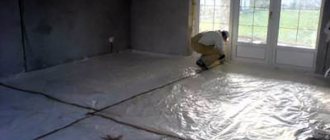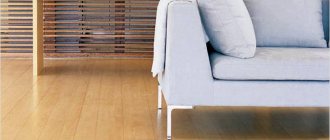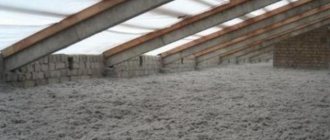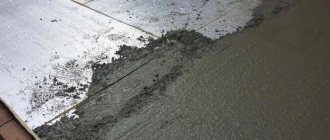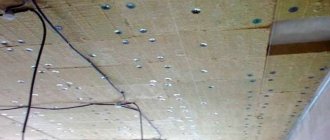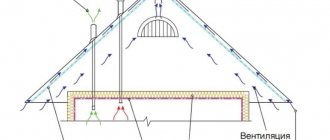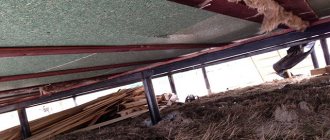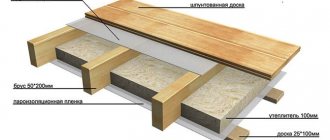Concrete is used not only for the construction of foundations and walls, but also for the construction of floors. A distinctive feature of concrete is the durability and strength of the material. However, a cold floor surface causes serious inconvenience, since the thermal conductivity of concrete is increased. When deciding to build a warm concrete floor, you have to decide how to insulate the base. It is important to choose the right insulation for a concrete floor and understand how thermal insulation materials are laid on the surface and waterproofing is performed.
Concrete floor base in a private house - features of a concrete slab
The floor is a critical element of the structure. Trying to increase the service life of a building, many people prefer concrete. After all, concrete surpasses most building materials in terms of performance characteristics. But along with a set of advantages, the material also has weaknesses.
Concrete has superior performance characteristics to most building materials.
Let's start with the main advantages of concrete floors, which include the following characteristics:
- increased safety margin. The concrete surface is able to withstand significant compressive loads, maintaining the structure and integrity of the mass;
- long period of use. The service life is commensurate with the service life of the building, thanks to the durability of the base;
- environmental cleanliness. The ingredients included in the concrete mixture are safe for health and do not harm the environment;
- ability to resist the accumulation of static electricity. Airborne dust is not attracted to the surface;
- Fire safety. The concrete base has increased fire resistance and is not destroyed by open fire;
- resistance to capillary penetration of moisture. Despite the reduced hygroscopicity, waterproofing the floor is a prerequisite;
- resistance to aggressive environments and chemicals. The concrete base is not destroyed upon contact with acids and alkaline compounds;
- maintainability. If necessary, it is easy to repair the damaged area.
Thinking about which insulation for a concrete floor is best, let’s look at the disadvantages of a concrete base. Main disadvantages:
- increased thermal conductivity. Without additional thermal insulation, significant heat loss occurs;
- condensation formation. Due to the increased temperature difference between the soil and the floor of the lower floor, moisture condenses on the concrete surface.
The concrete base has increased fire resistance.
Condensation causes a number of negative factors;
- increased indoor humidity;
- deterioration of the internal microclimate;
- development of fungal colonies and mold;
- formation of dampness.
In addition, in winter, cold floors cause many inconveniences to residents:
- reduce indoor temperature;
- increase heating costs.
But, thanks to a serious set of advantages, many people build a concrete floor. How to insulate its surface to avoid heat loss is of interest to owners of private houses, summer cottages and novice developers. Let's try to answer this question.
Basic requirements for thermal insulation of industrial and administrative buildings
When we talk about thermal insulation of an industrial building, we immediately mean the presence of an aggressive environment, large areas, metal structures and, as a rule, short deadlines for completing work. Therefore, the materials that will be used to insulate an industrial building must:
- be installed quickly so as not to slow down production processes for a long time;
- do not be afraid of the alkaline and acidic effects that are present in the air;
- if possible, protect metal structures of walls and roofs from excess moisture and corrosion;
- inexpensive.
If there is a question about insulating an administrative building, then there are also some requirements:
- insulation should not spoil the overall aesthetic appearance of the building;
- be installed quickly, since the administrative building is constantly in sight;
- thermal insulation should have a low price;
- The service life of the insulation should be as long as possible in order to avoid costly repairs.
And in both cases, of course, we should not forget about EFFICIENCY. The building must maintain the required temperature conditions.
As we can see, there are many requirements for insulation of industrial and administrative buildings and all of them are quite serious. But for sprayed polyurethane foam insulation this is not a problem.
Thermally insulating a concrete floor: how to insulate the surface of a concrete base
Specialized stores offer many different heat insulators with different performance characteristics. Many people prefer traditional materials and believe that for insulation it is enough to lay a layer of foam plastic or expanded clay granules. However, the choice of thermal insulators is not limited to this.
When choosing insulation for concrete floors, also pay attention to the following materials:
- mineral or basalt wool. They are a budget solution and belong to fibrous heat insulators;
- sheet expanded polystyrene. It has proven itself positively in rooms with high moisture concentration;
The choice of thermal insulators today is very large
- polyurethane foam. The material is sprayed onto the concrete surface using special equipment;
- wood sawdust. They allow you to thermally insulate a concrete base at low cost;
- polymer-based thermal insulation mixtures. Used when installing heated floors;
- heat-insulating paint. It is applied in liquid form to the surface of the concrete floor, insulating it;
- foam glass. Offered in the form of environmentally friendly blocks with increased moisture resistance;
- cork material. It consists of pressed slabs made from natural wood.
When deciding on a heat insulator, consider the following points:
- working properties of insulation. The efficiency of thermal insulation and service life depend on them;
- features of the building. The specifics of insulating concrete floors in a private house, multi-story building or country house are different;
- location of the concrete floor in the building. Possible options are the floor above the basement, the floor of the lower floor or the interfloor foundation;
- insulation method. Thermal insulation materials are used or a heated floor system is installed;
- location of the heat insulator. The insulation is placed between the joists or placed on the surface when screeding.
Let us dwell in more detail on the main operational properties of the heat insulators used.
Main characteristics of insulation:
- density. With an increase in specific gravity, the strength characteristics increase, but the thermal insulation properties decrease due to a decrease in porosity;
- margin of safety. The load capacity of the thermal insulation material affects its durability and allows it to maintain its original shape under load;
- thermal conductivity. Maximum insulation efficiency is achieved when using materials with reduced thermal conductivity;
Reliable thermal insulation depends on the thermal insulation materials used.
- moisture resistance. To insulate the concrete base, use insulation materials with reduced hygroscopicity;
- vapor permeability. Due to the ability of the material to pass vapors, the efficiency of air exchange increases;
- exploitation resource. Durability is one of the determining factors when deciding on floor insulation;
- weight. Give preference to lightweight thermal insulators that have sufficient density;
- environmental cleanliness. Try to use harmless materials for thermal insulation purposes.
Make your final decision taking into account the characteristics of the building and specific operating conditions. For example, in a country house where there are rodents, it is not advisable to use sheet foam. And if you want to reduce the distance from floor to ceiling, use granulated expanded clay. It is important to make the right decision by comprehensively analyzing all factors.
Common mistakes
In addition to the correct choice of insulation and calculation of thickness, you need to take into account a number of nuances. The first is preparing the material for installation. It is unpacked at least 1 day before the start of work and stored indoors at room temperature. So it will take on normal linear dimensions, which will not change significantly after installation.
The following factors are also taken into account:
- After installing the heat insulator, I install the upper decorative and protective surface (finished floor) as quickly as possible.
- Pre-treatment of lag with an antiseptic. This will protect them from the appearance of fungus and mold.
- The use of impermeable membranes to protect against water can cause an increase in humidity in one of the layers. It is better to use a vapor barrier.
- Sealing of joints, there should be no “bridges” of cold.
To insulate the floor of an apartment or residential building, you can install polystyrene foam in a continuous layer. It is more difficult to install basalt wool on logs. For the garage they make thermal insulation under the screed. All materials can be used here, including expanded clay. It is important to meet the basic conditions - good thermal insulation, mechanical strength of the surface. In apartments, allowable loads on interfloor floors are taken into account.
Characteristics of thermal insulation materials for insulating concrete floors
Let us dwell in more detail on the performance properties of the most common insulation materials:
- fibrous. A typical representative of fibrous heat insulators is mineral wool;
- leafy Among the many sheet insulation materials, polystyrene foam is most often used;
- crumbly. Of the various types of crumbly materials, granulated expanded clay is popular;
- sprayed. One of the representatives is a polyurethane foam mixture, sprayed using special devices;
- polymer. They are represented by an expanded range of self-leveling mixtures.
Expanded polystyrene is most often used to insulate concrete floors.
Let's start with mineral wool, which is offered in the form of rolls or individual mats. The insulation is made not only on a mineral basis. Along with mineral wool, wool is used using dolomite, basalt or limestone raw materials. Glass production waste and slag are also used for production.
The main advantages of the material:
- ease of use;
- Fire safety;
- increased plasticity;
- reduced thermal conductivity.
However, mineral wool can absorb moisture and needs additional waterproofing.
Extruded polystyrene foam is sold in sheet form. The material is a type of polystyrene foam, but differs from it in the following properties:
- increased strength;
- long period of use;
- increased reliability;
- fire safety;
- resistance to aggressive environments;
- environmental cleanliness.
Among the advantages of polystyrene foam sheets the following are also noted:
- noise insulation properties;
- moisture resistance;
- vapor permeability;
- reduced thermal conductivity;
- ease of installation.
The disadvantages include the increased cost of the material.
Granulated expanded clay is a very popular insulation material among builders.
Expanded clay is used in the form of granules made by firing clay. The main properties of expanded clay are:
- environmental friendliness;
- fire resistance;
- frost resistance;
- durability;
- reduced thermal conductivity.
Significant advantages also include the ability to absorb noise and the inability to form mold.
Polyurethane foam is a sprayed insulation material. Distinctive features of the material:
- reduced thermal conductivity coefficient;
- resistance to open fire;
- Possibility of use in damp environments.
In addition, there are no joint areas or cold bridges in the polyurethane foam coating. If it is necessary to further thermally insulate the surface, apply the first layer, after which it has hardened and then re-sprayed. The main disadvantage of polyurethane foam is the need to use special equipment to spray insulation onto the surface.
Polymer heat insulators include:
- working mixtures supplied in liquid form, intended for pouring heated floors;
- special paint, after application of which the thermal insulation properties of concrete increase.
The durability of the floor depends on the correct choice of material.
Advantages of polymer materials:
- thermal insulation characteristics;
- integrity of the formed layer;
- reduced hygroscopicity;
- resistance to temperature changes;
- perfect flatness.
Disadvantages include increased costs for the purchase of polymer materials.
You should carefully study and analyze the characteristics of thermal insulators when planning to purchase insulation for a concrete floor. In this case, it is necessary to take into account the actual conditions of use of the materials.
Coating structures
The coverings of industrial buildings, as a rule, are designed without attics. They consist of load-bearing and enclosing structures.
Load-bearing rafter structures are trusses, beams, arches and frames. They support the enclosing part, giving it the required slope corresponding to the roofing material.
The fencing includes flooring (reinforced concrete slabs, asbestos-cement or metal sheets, etc.), vapor barrier, insulation, leveling screed and waterproofing.
Non-insulated (“cold”) coatings lack vapor barrier and insulation.
In one-story industrial buildings, the most common coatings are large-sized slabs laid along the upper chords of rafter structures. When using decking made from small-sized elements, the latter are supported on purlins laid on the rafter structures.
Methods for insulating a concrete base and their features
It is not difficult to insulate a concrete floor after studying the technology of performing the work and mastering the specifics of performing thermal insulation measures for various types of insulation. Let's look at these points in more detail.
Fiber insulation for concrete floors
Fiber heat insulator is used to insulate concrete floors between floors of a building.
Lay slabs or roll material according to the following algorithm:
- Waterproof the concrete surface with plastic film.
- Cut and lay insulation on the waterproofing.
- Seal the joint areas with special tape.
- Place foil insulation on the insulating layer.
When performing work, pay attention to the correct location of the metallized film, which should be laid with foil towards the room. Then the heated floor communications are assembled on the prepared surface or sheets of plywood are laid.
Having studied the technology of performing the work, it is not difficult to carry out the floor insulation work yourself
Thermal insulation of concrete coating with polystyrene foam
The process of laying polystyrene foam sheets does not require special preparation. The thermal insulation material does not require waterproofing protection and is fixed with an adhesive composition directly to the concrete base.
Carry out work following the order of operations:
- Coat the concrete surface with a deep penetration antiseptic compound.
- Prepare the adhesive composition following the manufacturer's instructions.
- Apply a thin layer of adhesive to the boards and smooth it over the surface with a spatula.
- Place the heat insulator on the concrete surface and press evenly.
- Lay the remaining sheets according to the specified algorithm, ensuring that the joints are offset.
After laying the insulation, seal the joint areas with silicone, lay the mesh for reinforcement and pour the concrete screed.
We use expanded clay for thermal insulation: specifics of laying insulation
Expanded clay granules are used for thermal insulation of concrete foundations in private homes. When performing work, follow the specified sequence of actions:
- Waterproof the floor with polyethylene or mastic.
- Pour expanded clay onto the surface and level it.
- Lay the mesh for reinforcement.
- Prepare the screed solution in the required volume.
- Fill and level the surface of the screed.
After gaining strength, lay the finishing coating.
In private houses, expanded clay granules are used for thermal insulation of concrete foundations.
How best to insulate a concrete floor using spray compounds
Thermal insulation measures for applying sprayed insulation to a concrete floor are carried out only by professionals. After all, to carry out the work, you need special equipment that, under high pressure, supplies a layer of heat-insulating material to the surface of the concrete floor. As a result, a solid layer of insulation is formed. Distinctive features of the technology are the absence of the need to level the surface and seal joints.
Procedure for applying polystyrene foam:
- Clean the concrete surface and treat with primer.
- Secure the joists to the concrete floor using steel angles.
- Spray a layer of polystyrene foam.
When hardened, the material increases in volume, acquires a porous structure, penetrates deeply into cavities and seals microcracks.
How to use polymer thermal insulation
Polymer-based insulation is applied to the floor surface in an even layer. When performing work, follow the manufacturer's recommendations indicated on the packaging.
Follow the application procedure:
- Dust the concrete base.
- Treat the floor with a layer of primer.
- Apply polymer compound.
After the polymer insulation has dried, lay the finishing coating.
Horizontal heating
Some people believe that for a comfortable life it is enough to install a warm floor, any of the possible systems. But before installing water, electric or infrared heated floors, the concrete slab or screed must be insulated and properly insulated. Otherwise, half the power of your heated floor will simply go down, which will significantly increase the cost of using such a system.
Therefore, before installing horizontal heating, all measures for thermal insulation of concrete should be carried out, and before the finishing coating, the system itself should be installed. Concrete allows for all kinds of possible devices. Only the installation methods differ.
Before installing a floor heating system, it is necessary to lay thermal insulation
Calculation of the roof covering of an industrial building
Required heat transfer resistance.
The parameters of the enclosing structure are selected based on the required heat transfer resistance, calculated by the formula:
Where
— heat transfer resistance of the enclosing structure; — estimated indoor air temperature (); — minimum outside air temperature (); n
— the coefficient taking into account the location of the enclosing structure is adopted according to the SNiP -3-79 table (we accept
n = 1
);
— heat transfer coefficient, depends on the smoothness of the inner surface of walls and ceilings and takes values according to SNiP (smooth ceilings); — heat transfer coefficient, determined according to SNiP (for roofing); - the standard temperature difference between the air temperature in the room and the temperature of the internal surfaces of the enclosing structures is accepted according to SNiP (based on the condition “industrial buildings with normal operation” we accept); R
is the thermal resistance of the construction material, determined by the formula
,
Where
- thickness of the total layer,
-thermal conductivity for normal mode and normal climate, i.e. mode A:
Knowing , we derive from formula (*) the thickness of the roofing materials:
where is the thickness of the insulation, hence,
For roof insulation we use mineral wool mats, and for waterproofing - three layers of roofing felt on a bitumen base with a total thickness of 15 mm.
Thermal characteristics of roof insulation materials.
Table No. 2.
| Material. | Volume weight, | Heat absorption S, W/ (m2*C) | Thermal conductivity l, |
| Mineral wool mats | 75 | 0,46 | 0,05 |
| Bitumen | 1400 | 5,79 | 0,23 |
| Ruberoid | 600 | 3,06 | 0,15 |
Then,
— mineral wool mats with a density of .
As waterproofing:
- roofing material at density and -bitumen at density . From here we find the average thermal conductivity value for waterproofing: .
We substitute these values into the formula (**):
We round the resulting value to a multiple of 50 mm. Then, the thickness of the mineral wool layer should be at least 0.05 m
Examination.
Because — the condition for heat transfer of the enclosing structure is met, therefore, the calculation is correct.
Thermal inertia:
, Where
— thermal resistance of the i-th layer.
S1= 0.46 - heat absorption of mineral wool, W/ (m2*C);
S2= 4.425 - average heat absorption of roofing felt and bitumen, W/ (m2*C);
d1= 0.05 - thickness of the mineral wool layer, m;
d2= 0.015 - thickness of three layers of roofing material on a bitumen base, m.
l1= 0.05 - thermal conductivity of mineral wool, W/ (m*C;
l2 = 0.19 - average thermal conductivity of roofing felt and bitumen, W/ (m*C).
,
, Then,
Conclusion: for roof insulation we use mineral wool mats, and for waterproofing - three layers of roofing felt on a bitumen base with a total thickness of 15 mm.
To fill the window openings, we choose double glazing in metal frames.
Nuances of fastening insulation
Whatever material is chosen, it must be firmly fixed to the base. For these purposes, you can use two methods:
- Bonding to bitumen. A labor-intensive and expensive process, justified only if there is a concrete base, since more expensive specialized dowels will not be required and there will be no need to drill holes for them.
- Mechanical fastening using special telescopic dowels. They have a very wide cap, due to which they cannot pierce the waterproofing and thus do not violate the tightness of the flat roof.
There is a building rule according to which the waterproofing carpet is attached to the insulation in the same way as it is attached to the base. When using a mechanical fastening method, it is better to use polymer-bitumen fusible material as a vapor barrier. Its special elasticity helps to tighten without consequences the small holes inevitably punched by the dowel on which the insulation is attached. If two-layer insulation is used, the slabs must be laid “in a staggered manner” so that the joints of the slabs of the lower layer are necessarily covered by the upper one. In this case, the so-called “cold bridges” do not form. Each insulation board is secured with at least two dowels.
The layers of the “roofing cake” must be securely fastened
Temperature and comfort inside a building largely depend on proper insulation of the flat roof. By choosing the right materials and carefully following construction technology, you can get an excellent structure that will serve flawlessly for many years, both as a traditional covering and as the basis for a recreation area, terrace or roof garden.
Choose single-layer or double-layer thermal insulation
First of all, you should consider the installation of a flat roof - insulation can be planned in two ways:
Single-layer thermal insulation system. The main distinguishing feature: the entire insulating layer is made of flat roof insulation of the same density. If it is planned to construct a roof that is in use, then a concrete screed is laid on top of the heat-insulating layer. This system is most often used when repairing old roofs or in the construction of garages, warehouses and industrial buildings. The two-layer thermal insulation system is designed differently. The top layer, 30-50 mm thick, is made of insulation of increased strength and density. It is designed to redistribute mechanical load. The lower one, with a thickness of 70 to 170 mm, performs the main heat-insulating function
This design allows you to significantly reduce the weight of the roof and, accordingly, reduce the load on the floors, which is very important when renovating old buildings. There are modern materials that combine the properties of both layers
These insulation materials have a hard top edge and a softer bottom edge. Installation of such slabs occurs very quickly and reduces the time and labor costs for installing the coating.
The two-layer system guarantees the absence of through seams in the thermal insulation layer
Find out the cost of thermal insulation for your specific premises
We will call you back at a time convenient for you
PROPERTIES OF POLYURETHANE FOAM, SO NECESSARY WHEN INSULATING A WAREHOUSE
The only drawback of polyurethane foam is its exposure to ultraviolet rays. However, this problem can be solved by simply painting the thermal insulation with any paint that will protect the surface.
Naturally, it is impossible to create the necessary microclimate in the warehouse only by thermal insulation of the room. Therefore, in combination with insulation, it is necessary to take care of high-quality, well-designed ventilation. This complex will help make your warehouse an ideal place to store any goods.
Most modern private entrepreneurs, as well as various firms, enterprises and factories, have warehouses at their disposal. As a rule, finished products, goods for sale, consumables, raw materials and much more are stored in warehouses.
Whatever is contained in these structures, if the warehouse is not properly insulated, during the cold winter or hot summer periods of the year the contents of the warehouse risk becoming unusable or losing their original characteristics.
